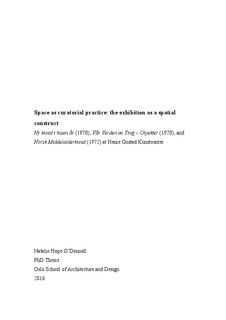Space as curatorial practice: the exhibition as a spatial construct : Ny kunst i tusen år (1970), Vår verden av ting - objekter (1970) and Norsk middelalderkunst (1972) at Henie Onstad Kunstsenter
Doctoral thesis, Peer reviewed
Permanent lenke
http://hdl.handle.net/11250/2398244Utgivelsesdato
2016-08-09Metadata
Vis full innførselSamlinger
Sammendrag
Space as curatorial practice: the exhibition as a spatial construct asserts the fundamentally spatial nature of the object of research – the exhibition – and the thesis seeks to make a contribution to Exhibition Studies, which is an emerging discipline, productively situated at the intersection of the four other disciplines: Art History, Architecture, Museum Studies, and Curatorial Studies. The hypothesis of this research project is reflected in its title, which posits that the practice of curating is fundamentally spatial, made manifest through the exhibition as a spatial construct.
The title also alludes to the theoretical framework that informs this thesis and underpins its approach, which I will briefly mention here, but will explore in more detail in the first chapter on the respective academic disciplines that this research project draws on. The operative definition of space used in the thesis is derived from architectural theory, and draws on the work of August Schmarsow, who proposed the notion of ‘spatial construct’ in the 1890s, at the time when the term ‘space’ first emerged in architectural discourse. 1 The thesis also uses Henri Lefebvre La production de l’espace (1974) to see space as constantly being produced as part of a three-part dialectic of forces. The reference of ‘curatorial practice’ in the title seeks to mediate between ‘curating’ and ‘the Curatorial’, an on-going debate within Curatorial Studies. The exhibition is experienced as a spatial construct via a bodily movement through an exhibition space. The experiential approach to perception draws on Maurice Merleau-Ponty’s seminal work Phénoménologie de la perception (1945),
which had such an impact on the Minimalists’ approach to space in art exhibition after its publication in English in 1962.2 These phenomenological ideas around art in exhibition, which art historians were central to mediating, flourished around the same period that this thesis is concerned with: the late 1960s and early 1970s.
